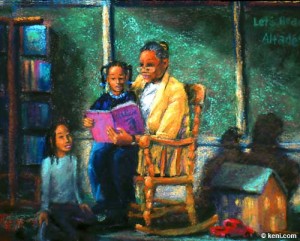 Children’s books are opening to a new chapter thanks in part to enhanced and interactive book apps. Along with technology, the talents of authors and illustrators are migrating to this medium.
Children’s books are opening to a new chapter thanks in part to enhanced and interactive book apps. Along with technology, the talents of authors and illustrators are migrating to this medium.
Technology is playing a major role in developing content for children’s books. Yet, any exciting new technology could generate a distorted sense that we have struck the mother-load of success and prosperity. In reality, we have just scratched the surface of some shinny new thing. Only time will tell if the current rush to enhanced and interactive ebooks will be a passing trend or a lasting tradition.
This we can be certain of; as long as parents continue to give birth to children, the need for children’s literature will grow as well. The other side of that coin is this; as readers mature, the demand for books will eventually peak then decline; sometimes abruptly.
Before we look at the tools available to produce children’s books, let’s look at what’s trending in what children are reading. In the article, ‘A Look at Current Children’s Book Trends’, Laura Backes points to topics editors are buying. At the top of her list are poetry, story collections and picture books with short texts.
From my personal observations, I see classic titles in public domain appearing in Apple’s AppStore in the children’s books category. For example, you’ll find numerous versions of Alice in Wonderland, Three Little Pigs, Twas the Night Before Christmas, Cinderala and others being retold in new ways using digital tools.
Producing a book app can be a daunting task. Yet getting it into the little hands of a reader may be where the real challenge lies. Sophie Rochester wrote in her article, ‘Storytime Goes Digital: Assessing the Children’s E-Book and App Market… The key difference here goes beyond content, to the question of discovery: When illustrated e-books are sitting on a shelf in a category the iBookstore, are they more likely to be found by readers than an interactive app in the App Store?
At least two developers are set to answer the question of discovery. DemiBooks and InteractBooks are using an app store within the App Store model. Yes, it’s Apple-approved. These developers allow you to download their app free from iTunes. The free app usually includes at least one book. Parents can then get additional books through the in-app purchase model. Developers have been reaching out to authors and illustrators to create within their platform to ensure that there will be an ample selection of books to chose from.
This ‘strength in numbers’ model will likely be a great way for new and/or unknown authors with limited budgets to compete with the hundreds of thousands of apps in iTunes App Store.
The medium of digital storytelling for children’s books is both in flux while exciting. Many established children’s book publishers seem to be taking baby steps in the interactive book app space. Meanwhile, start-ups, independent authors and illustrators are leaping ahead like kids in a candy store.
What do you see on the horizon for children’s books?
